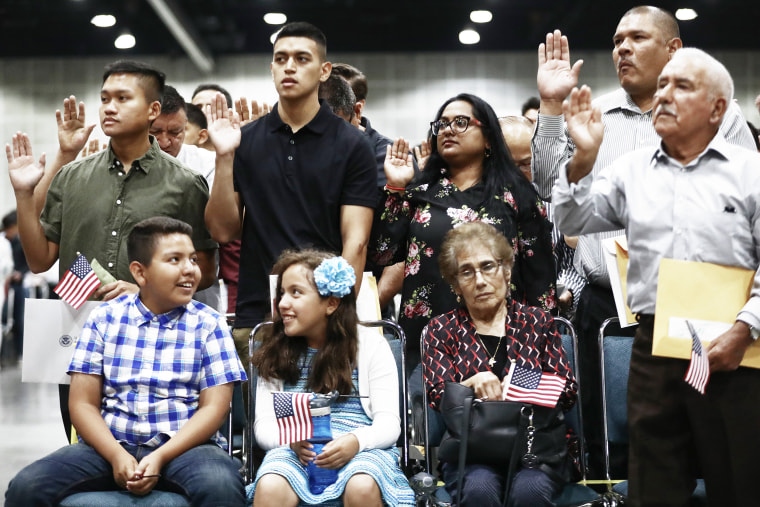LAS VEGAS — It was the eve before Nevada’s caucuses and Eddie Ramos sat on an amphitheater lawn at a county government building waiting to once again hear Sen. Elizabeth Warren, D-Mass., speak.
Ramos, 56, born in Mexico, moved to the United States at 18. An employee of Caesar's Palace, he is part of the population of naturalized citizen voters that has nearly doubled in the last two decades, rising from 12 million in 2000 to 23.2 million in 2020.
One in 10 Americans eligible to vote this election is an immigrant, a record high, according to a Pew Research report released Wednesday.
"I like to be more informed basically about what's going on and what's affecting the community, as a citizen," said Ramos.
"We often think about voters through the lens of race and ethnicity, but a growing part of the electorate are immigrants. And while most are Asian or Hispanic, there are significant numbers of black immigrants and white immigrants too," said Mark Hugo Lopez, Pew's director of global migration and demography research and one of the report's authors.
According to Pew, 34 percent of naturalized citizen voters are Latino and 31 percent are of Asian descent.
Sixteen percent of all foreign-born voters are like Ramos, from Mexico, and at 3.5 million, they make up the largest group of eligible immigrant voters. They're followed by voters from the Philippines (1.4 million) India (1.2 million) and China (1 million).
Turnout rates among Hispanic and Asian foreign-born immigrants are higher than among U.S.-born people in those populations.
About 22 percent of foreign-born eligible voters are white immigrants, numbering about 4.8 million, and making them the third largest racial and ethnic group, Pew reported. Black immigrant eligible voters number about 2.3 million. Their share of the immigrant electorate has grown from 7 percent in 2000 to 10 percent in 2018.
The shifting voter landscape
"While our report explores the demographics of immigrant eligible voters, it doesn’t explore the reasons for naturalization," Lopez says. "Even so, in the past we’ve found that among Hispanic immigrants who are eligible to naturalize, voting is one of many reasons why they choose to naturalize."
Eligible voters who immigrated to the U.S. mostly live in California, New York, Texas and Florida. Two-thirds have lived in the country more than 20 years and 63 percent are proficient in English, the report said.
Only a quarter (25 percent) of Latino voters are immigrants. But among Asian Americans, two thirds of eligible voters are immigrants. Among African Americans, immigrants account for 8 percent of voters; among whites it's 3 percent.
At about 215 million, the number of U.S. born voters is still vastly larger than the foreign-born voter population. But while the number of immigrant voters has been expanding, the growth of the U.S.-born, eligible voter population has slowed, Pew reported.
The Pew Research Center did not include data on the party preferences of immigrant voters but recent elections show immigrant voters have leaned Democratic as Republican views have hardened.
A carpenters' union member, Ramos had weighed the promises of Bernie Sanders' health care proposals with Warren's and decided it would be tough to get Sanders' plan through the House and the Senate.
He said he liked Warren's positions on health care, equal rights for everybody, education, the national debt and immigration.
But ultimately what he wanted as a voter was: "Get Trump out of the White House," he said.
President Donald Trump's re-election campaign told the Los Angeles Times that many legal immigrants agree with Trump because their families entered or stayed in the U.S. legally and support requiring others to do the same.
In a June 2019 poll by the Latino Decisions polling firm for UnidosUS, 20 percent of Latinos who are naturalized citizens said they definitely or probably would support Trump in the election, while 61 percent said they would definitely or probably support a Democrat. Nineteen percent were undecided.
In a September Latino Decision poll for Univision, 73 percent of naturalized citizen Latino voters said they would vote for or were leaning toward a Democrat and 16 percent said they plan to vote for or were leaning toward Trump.
The Census Bureau reported that in 2018, voting by naturalized citizens increased 12 percent, the same increase seen in native-born citizens. Almost half of naturalized citizen eligible voters turned out in the 2018 midterms, compared to 54 percent of native-born citizens, the bureau reported.
From 1965, when the Immigration and Nationality Act became law, the immigrant population grew from 5 percent of the population to 13.9 percent, which is part of the reason for the growth in the foreign-born voter population.
One reason for the growth in the immigrant voter population is that the number and share of immigrants who have become citizens have increased in recent years: From 2009 to 2019, 7.2 million immigrants naturalized and became citizens, the report stated, citing Department of Homeland Security data. In 2018, more than 756,000 immigrants became citizens.
Follow NBC Latino on Facebook, Twitter and Instagram.

